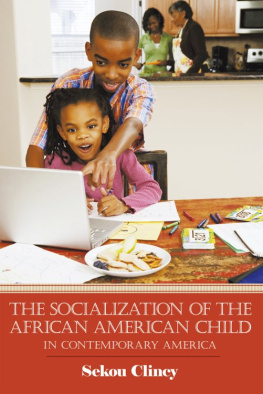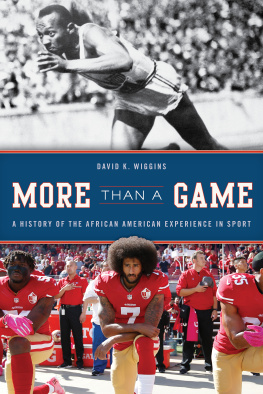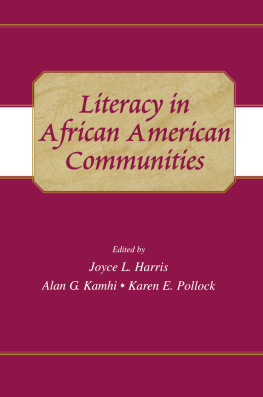The Socialization of the African American Child:
In Contemporary America
Sekou Clincy

AuthorHouse
1663 Liberty Drive
Bloomington, IN 47403
www.authorhouse.com
Phone: 1-800-839-8640
2011 Sekou Clincy. All rights reserved.
No part of this book may be reproduced, stored in a retrieval system, or transmitted by any means without the written permission of the author.
First published by AuthorHouse 2/15/2011
ISBN: 978-1-4490-8787-6 (sc)
ISBN: 978-1-4490-8788-3 (dj)
ISBN: 978-1-4490-8789-0 (e)
Printed in the United States of America
Any people depicted in stock imagery provided by Thinkstock are models,
and such images are being used for illustrative purposes only.
Certain stock imagery Thinkstock.
Because of the dynamic nature of the Internet, any Web addresses or links contained in this book may have changed since publication and may no longer be valid. The views expressed in this work are solely those of the author and do not necessarily reflect the views of the publisher, and the publisher hereby disclaims any responsibility for them.
DEDICATIONS

This book is dedicated to Dr. Harold Aldridge Jr. and future
generations of children and youth. It is my hope that you
search for truth and make this world a better place.
ACKNOWLEDGEMENT THANK YOU

This book would not have been written without the encouragement, commitment, and help of a talented group of people. First, my thanks go to the countless parents and caregivers, and extended kinship who share a genuine concern for African American children and culture. Thanks also to all of the researchers who provided invaluable insight and scientific information in the beginning stages of this book. A warm thank you to all of the children and staff Ive worked with over the years as a counselor, recruiter, fatherhood coordinator, and health education specialist. Extra special thanks to the University of Oklahoma for all of its resources. Thank you to the Clincy, Grimmett, and Collins families for their time, advice, and support. Thank you, Gwen and Lisa for all of your brilliance. I couldnt have made it without you two.
Thanks to all of the scholars and people in the trenches who sacrificed time and family to give birth to this book.
FOREWORD

The work of Mr. Clincy is very timely and very important to the current state of African American children across the United States. In unprecedented numbers, there is senseless teen violence, teen pregnancy starting at the ages of 12 & 13, and the ages of youthful offenders starting earlier than has been seen in any recent time. The one place that should serve as a safe haven and sanctuary (the schools) is failing the urban and underprivileged student. These are situations in which African Americans live daily. How can we expect these children to rise above this reality if they are not shown an alternative?
In reading The Socialization of the African American Child, I had to pause and perform a self-assessment/self-reflection to determine how I was not one of the children discussed in this work. From 0 to 9 years of age, I grew up in an urban neighborhood. Our neighbors were a mix of retired Black senior citizens; grandmothers raising their children and grandchildren; two parent homes; and single parent homes. The stereotypes typically displayed in the media were present. The reality was not as exaggerated as the media depictions. I vividly recall my parents letting my brothers and I know that although we lived in this environment we were not part of this environment. My parents had high expectations of us because they wanted more and better opportunities for us than they had.
To ensure that their children were successful, both of my parents were present and active in our lives. We were taught right from wrong. My parents were involved in homework and encouraged extra-curricular activities of our interest. There were no limits placed on our dreams. The one constant was that education was the key to whatever we decided to do.
I was fortunate in my educational experiences. My experiences in both the urban and what is called the mainstream school districts were of teachers pushing their students to excel. Students identified as gifted were either given extra credit work or placed in classes that exposed the students to different subjects. For example, I was enrolled in a mythology class in the 5 th grade, and in the 8 th grade I was selected to take Algebra I. (In the 80s it was uncommon for Algebra to be taken so early.) There was also more of a focus of students mentoring fellow students. In the schools I attended, there were tutoring classes where students who were struggling could go to get help. Lastly, teachers were more focused on preparing students for college than teaching to pass standardized tests.
What we are now seeing is more students failing at earlier ages because the pace of instruction has quickened to ensure all material of the standardized test is covered. The basics of what I am familiar with is not being taught at a sufficient level. The unintended effect is a low level of retention of the material that is being taught to students. This is particularly troubling for African American and disadvantaged students who are in urban neighborhoods.
To this end, I am part of a non-profit organization, Making Better C.H.O.I.C.E.S., whose vision is to serve disadvantaged communities and to aid and empower disenfranchised individuals both socially and economically. We want to help the disadvantaged develop the necessary tools and skills to be assets in their communities. The African American community is our particular interest.
Our work focuses on developing programs to address the educational, the economic, and the social needs of the African American community. Our biggest challenge will be to understand the environment in which these children are exposed to and develop programs that are relevant to their world. African American children are exposed to so much more than what I was exposed to at their age. Children now are influenced by their peers, media (entertainment), and in some instances familial relations. These influences in most instances are negative and do not provide these children with a sense of hope or an opportunity for an alternative. This is where The Socialization of the African American Child is such an asset to Making Better C.H.O.I.C.E.S., Inc. Our vision of empowering African American children cannot happen without first understanding where we came from and why we are where we are. The material in this book is an essential piece to that understanding.
Lisa A. White Sagacity Management Consultants, LLC
Table of Contents

1. Education
3. Religion and the Contemporary Black Church
List of Tables and Figures

Table 1.1 World Education Rankings
Table 1.2 Homework Ranks behind Other Pursuits
Figure 1-1. Percentage of Kindergartners Rated by as Never or Only Sometimes Behaving in Ways Conducive to Learning, 1998
Figure 1-2. The Four-Year Gap: How Black and Hispanic High School Seniors Perform Compared to Whites and Asians in the 8th Grade
Next page













